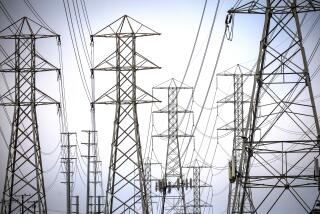Power: Who Is the Real Freeloader?
Throughout California’s power crisis, only one message has been louder than “don’t let my lights go out.” That is the refrain of California’s “consumer representatives”: “Don’t raise rates; don’t bail out the utilities.”
This Johnny-one-note approach, largely ignoring the more fundamental challenge of keeping sufficient electricity flowing to the homes and businesses of California consumers, has more than a hint of surrealism and selfishness. This was most recently reflected by the reported statement of Harry Snyder of the Consumers Union:
“[The state] will be bailing [the utilities] out, make no mistake about it . . . How do we know that Edison and PG&E; are going to pay us back?”
Because such statements have been reported nearly daily since the public discussion of the electricity crisis began, it carries the danger of repeating a lie or misunderstanding so often that it becomes the truth.
Let’s review the basic facts and ask who is bailing out whom. Since May 2000, Edison, PG&E; and SDG&E; have paid approximately $12 billion more for the electricity distributed to, and used by, ratepayers than ratepayers have paid to them. As Gov. Gray Davis so forcefully expressed in his State of the State address, these undercollections have had the effect of enriching power suppliers while nearly bankrupting the utilities.
Edison and the other utilities made virtually all of their power purchases through state-sanctioned agencies (the Independent System Operator and California Power Exchange) whose function it is to buy and then resell the electricity to the utilities.
These state-created “middlemen,” controlled by a board composed of all major interest groups, including utilities and consumers, have done their best to acquire sufficient power. Nonetheless, whether for legitimate or illegitimate reasons, their actual cost of power skyrocketed from about 3 cents per kilowatt-hour historically to nearly 30 cents per kilowatt-hour in December 2000. This cost was passed on to the utilities, but the utilities have been prohibited by a state-imposed rate freeze from passing the cost along to ratepayers.
Among the legitimate reasons offered for the spiraling cost of electricity is the tight supply, a supply that worsens yearly as California’s environmental controls make it more difficult and expensive for the older generating plants to operate full time. By way of example, one generator reported that the effect of waiving the emission controls on oxides of nitrogen, or NOx, for just one of its plants for 2001 would triple the amount of power that could be generated by that plant. Similarly, the price of NOx emission allowance fees has zoomed from $2 per pound in February 2000 to more than $40 per pound in January 2001 (for many plants, there is about one pound of emissions produced for every megawatt hour of electricity generated).
The point is not that environmental controls are wrong, but that they are expensive. Someone must pay, and fair-minded consumer advocates who also champion these environmental controls must recognize that costs accompany benefits.
Similarly with electricity purchases, there is no fair-minded principle that dictates that the consumers of power should get the use of that power without paying its costs. Indeed, last week, U.S. District Judge Ronald S. W. Lew said as much, ruling that California’s rate freeze could not be used to stymie the federal law principle that utilities’ reasonable (with reasonableness tested only against the utilities’ prudence, not the seller’s behavior or charges) costs for electricity must be paid by the ratepayers who consume it. This federal principle is long-standing.
Rather than recognizing the federal law and common-sense principle that one must pay the fair share of one’s consumption, the consumer advocates irresponsibly repeat their mantra: no higher rates; no utility bailout.
Isn’t it time for some consumer group to separate itself from that irresponsibility, recognize that the utilities to this date have bailed out consumers from the skyrocketing wholesale prices, and support the governor and legislative leaders who are crafting ways to reduce future wholesale prices and spread the costs of past purchases (the utilities’ net undercollection) in a way that will avoid the rate shock of the 300% increases experienced by San Diegans this summer? In short, this legislation would allow a state agency to negotiate more freely and effectively to lower long-term prices and dedicate a small portion (less than 1 cent) of existing rates to pay for the past undercollection.
Constructive consumer advocates will--as I believe most consumers will--eschew the free-rider attitude, work to support the urgently needed pending legislation and recognize the unfairness of visiting on the utilities the excessive costs of the past. This should be especially easy to do for those who understand that Edison’s ratepayers are today paying rates that are nearly the same as in 1991 and who understand that the utilities are not inanimate objects. They are thousands of shareholders (Edison has 85,000 shareholders in California) and employees (hundreds are now being laid off by Edison) who have seen their companies teeter on the mantle of bankruptcy, their dividends eliminated and their companies’ market value fall precipitously.
More to Read
Inside the business of entertainment
The Wide Shot brings you news, analysis and insights on everything from streaming wars to production — and what it all means for the future.
You may occasionally receive promotional content from the Los Angeles Times.










